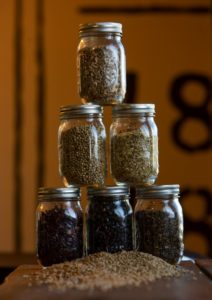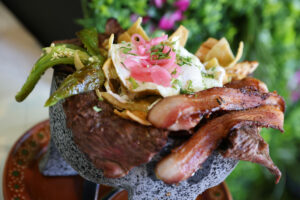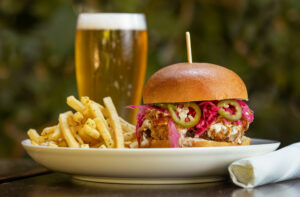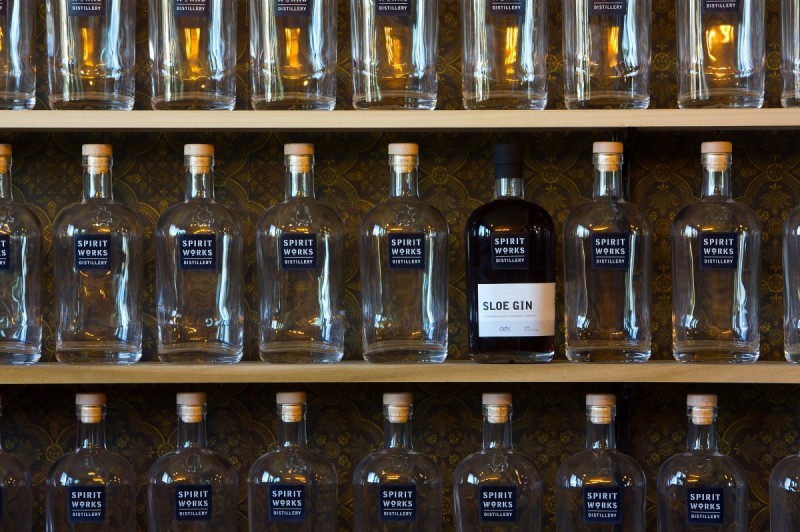After Timo Marshall proposed to his girlfriend, Ashby, he wanted a meaningful gesture to break the news to her parents. So he gave them a bottle of his family’s traditional, homemade sloe gin.
“That was the biggest thing I could think of doing,” the U.K. native recalled nearly a decade later.
Now the Sebastopol couple want to bring sloe gin to the rest of America, producing what they say is the first traditional English version made in the U.S. The Marshalls founded Spirit Works Distillery in 2013 with a specific eye toward creating the unjustly obscure liquor.
They started out thinking they would buy a farm and grow sloe berries and other products to help some local distillery make a traditional gin. But two things quickly became clear. First, the Marshalls didn’t have the time or money to create such a high-risk, small-audience farm. And second, there wasn’t a small distiller that makes the base liquors —vodka and gin — in the exacting manner that the couple had in mind.

So the Marshalls decided to do it themselves, learning from scratch how to make liquor.
Their distillery, in Sebastopol’s new Barlow district, is a gleaming showpiece, with three separate stills enabling head distiller Ashby to make liquors of all sorts, starting with their vodka and gin.
What distinguishes Spirit Works from many distillers, however, is that the Marshalls control every aspect of the process, starting with buying the wheat they grind and brew into the base mash that becomes the liquor. Many distillers purchase premade mash, or even buy premade liquor to infuse with other flavors.
The Marshalls grind California winter red wheat to a fine flourlike consistency, mix it with hot water to make a mash (similar to the process used by beer brewers), then distill that mash into vodka. To that vodka, they add various herbs and spices and redistill it to create gin. That in turn becomes sloe gin when the sloe berries are steeped in the gin to extract the fruit flavor.
“The important thing always to come back to with us is we are a grain-to-glass facility,” Timo said. Since there are hardly any sloe berries grown in the U.S., Spirit Works turned to a source in Eastern Europe. But the rest of the ingredients are sourced as locally as possible.

The process of making sloe gin is straightforward: soak some of the small sloe berries (a relative of the plum) in liquor to extract the purple color and bitter fruity flavor, then add some sugar and let it age.
The result is a silky, fruity concoction that is similar to a rich Port or a French cassis, the liqueur often mixed with Champagne to create a kir royale.
Like many Englishmen, Timo grew up in a family that foraged for sloe berries in the fall; the fruit is freely available on the blackthorn bushes used by many farmers to create hedgerows around their fields.
Collecting the berries, painstakingly preparing them to soak in the liquor, and bottling the sugared juice are part of nostalgia in the English countryside, he said. Families bond over the process, often sharing glasses of the previous year’s product while making the new batch.
“No one farms sloes. … In the autumn we would take these walks: In the U.K., you can walk anywhere, there are public footpaths over everyone’s farms, and you can just forage in the hedgerows for whatever is there at the time,” Timo said. “Most families out there will make a couple bottles or six bottles of sloe gin every autumn.”
Unfortunately, commercial sloe gin has gotten a bad name in recent decades, made with cheap liquor and low-grade flavorings. Only a handful of distillers around the world make sloe gin the proper way.
In its more traditional, professionally produced form, Timo and Ashby said, sloe gin is more bitter and less sweet than the homemade stuff; this allows bartenders to more finely control the flavor profile of cocktails.

But even with the differences in homemade sloe gin, the Spirit Works version has gotten a thumbs-up from an important critic: Timo’s father. “He told me, ‘Your great-grandmother would definitely have approved,’” Timo said.
Michael Cecconi, bartender at San Francisco’s Two Sisters Bar and Books and consultant to Sebastopol’s Zazu restaurant, said that Spirit Works’ sloe gin, which sells for around $40 a bottle, revives a “wonderful tradition with a local product.” The intense fruit flavor and modest alcohol (54 proof) make it an excellent ingredient for bartenders looking to make relatively low-alcohol cocktails.
The distillery’s great story, combining family history with the farm-to-glass, do-it-yourself ethos, appeals to customers, particularly in the Bay Area, who are interested in artisan production.
But it’s not just customers who are happy. One of the side benefits of finally debuting their dream drink, Timo said, is that they now have enough sloe gin on hand to actually indulge in a few glasses once in a while, rather than hoarding the annual harvest for special occasions.
“It’s so hard to come by … it’s so luxurious for us to be able to go to our pantry and have a couple of glasses of sloe gin,” he said.










